Chances are that if asked to sketch an anchor, you and almost everybody you know would most likely draw the exact same shape. That shape would be the Admiralty Pattern anchor.
Found on Popeye the Sailor Man’s tattooed forearms and centuries of ship-worthy muscle, the Admiralty Pattern anchor was the first universally successful design, its evolution the culmination of more than 2,000 years of sea-going vessels creating whatever worked (and much that didn’t) to hold ships in place.
This naturally began with giant stone blocks touting holes for ropes (or the “rode” in naval parlance) to combinations of stones and wood spikes to dig into the seabed.
The ancient Greeks utilized a variety of designs, including logs filled with lead, while the pre-European Maori canoes used hollow stones tied with flax ropes. These designs worked well for light vessels since they relied only on sheer mass and friction with the seafloor, but as time progressed and larger ships were built, new designs emerged to handle the challenges of securing large vessels to mud, rock, sand, coral and every combination possible.
Some fluke
The introduction of flukes, better described as teeth, made for anchors that would dig into the bottom or catch on rocks and other formations. This allowed for an anchor able to hold against stronger currents or raging storms.
This type includes the Admiralty Pattern, which utilizes a central shank with the large flukes at the base and stocks – essentially a T-bar at the top – at a ninety-degree angle to the flukes. After falling to the bottom, the anchor would be pulled along by the rode (rope) with the stocks flat on the seabed, causing the bottom fluke to dig in.
Further developments resulted in stockless anchors, which included the addition of a pivot to the flukes and tripping palms to help the flukes set into the seabed. Numerous other designs have emerged for small anchors intended for vessels not needing such power-to-weight ratios, though some are still very capable of holding against strong currents and adverse conditions.
Ingenuity is one of the hallmarks of maritime activities and those whose very lives depended upon the equipment they designed. Anchors are a clear example of a heritage of cleverness, and as such have also become iconic symbols for implying a connection to the sea.
Inspired by one of the greatest
So if you had founded a watch brand inspired by one of the greatest watchmakers in history, a man who had made chronometers that accompanied famous travelers on legendary journeys across the seas, wouldn’t you want a little nod to the seagoing nature of your inspiration?
You might or you might not; I wasn’t really asking you anyway. But I was rhetorically referring to Arnold & Son, the relatively young brand founded only in 1995 that has its roots firmly planted in the tradition of John Arnold and the chronometers he and his son created 250 years ago.
The brand’s logo most appropriately includes the Admiralty Pattern anchor and its timepieces display the ingenuity and craftsmanship that was ever present in John and John Roger Arnold’s pieces, which helped shape modern watchmaking so long ago.
Arnold & Son’s wristwatches excite and inspire me because they are a mix of classic styling and modern design, with a dash of ingenious mechanism detailing to satiate even the hungriest of watch nerds.
Offsides
A popular Arnold & Son element is the true beat mechanism, and a new model introduced at Baselworld 2014 brings it front and (almost) center. The DSTB, which stands for “Dial Side True Beat,” isolated the true beat (a.k.a. dead seconds) mechanism from the TB88 model and brought it, as the name implies, to the dial side, creating a presentation of the Arnold & Son ingenuity.
The name also very clearly implies the previously mentioned connections to the sea as the true beat seconds escapement lever is shaped – you guessed it – like the Admiralty Pattern anchor. Those things really are everywhere!
But the anchor-shaped lever isn’t the crowning jewel on that mechanism; the mechanism itself is the crowning jewel.
It all starts, in my eyes, with the bridges. Shaped like chronometer bridges of yesteryear, they are directly inspired by watches John Arnold crafted in his prime. But like everything Arnold & Son, a modern twist is applied with the skeletonizing of all three: they thus allow a clear view of the wheels while keeping the multiple bridges from seeming heavy or the dial from feeling cluttered.
Those bridges also happen to be red gold-plated and finished with satin blasting, straight graining, and polished hand-beveled edges, which helps to remind you of the variety and quality of finishing in an Arnold & Son piece.
Unlike pieces created by John Arnold long ago, however, the DSTB really is about showcasing the mechanism: underneath those bridges lays a very clean and clever true beat mechanism providing crisp full-second ticks from the second hand.
This begins with the running seconds wheel, which engages with a pinion attached to the lever. The wheel causes the pinion and lever to slowly “walk” up the true beat wheel.
This allows a pallet jewel to slide off of the v-shaped notches in the true beat wheel, which then lets the wheel advance. During this instant, the pinion rolls back to its original position and brings with it the lever and previously mentioned pallet jewel, locking the true beat wheel into position and the process begins again.
This process takes precisely eight oscillations of the balance for each cycle within the four-hertz movement of the DSTB.
Remaining visible
Just like the skeletonized bridges, all the rest of the components of the true beat mechanism are finished with straight or circular graining and hand-beveled and polished wheels, lever, and spring.
The mechanism sits below a seconds chapter ring cut from solid sapphire crystal for maximum visibility. Cutting sapphire to any shape beyond round and then adding holes is a tough task, but worth the effort for the beautiful DSTB.
The chapter ring sits on another throwback to the chronometers of John Arnold: candlestick-shaped pillars, which are used to hold and separate the base and main plates.
This timepiece continues the juxtaposition of modern and classic that Arnold & Son does so well, and it works perfectly.
The dial of the DSTB is simple, white, lacquered, and round with Roman numerals and a chapter ring for minutes sitting within a screw-mounted gold ring. Skeletonized, blued hands round out the presentation of both the dial and the true beat seconds.
The dial and true beat mechanism sit upon a snailed back plate that has an NAC grey treatment. This is another modern addition that was largely overlooked, even in the press release. NAC stands for “NanoAmorphous Carbon” coating, which is applied using Plasma-Enhanced Chemical Vapor Deposition (PECVD).
Usually used to create a dielectric film (an electrical insulator that can be polarized by an applied electrical field allowing for controlled conductivity or insulation), NAC is created mainly from carbon, silicon and oxygen, sometimes with various conductive metals added for a desired conductivity range. While technically applied here for visual purposes, the coating does have high hardness and wear resistance, a low friction coefficient, and biocompatibility, among other things.
The proverbial star of the show
As anyone might remember, what makes this watch nerd giddy are clever mechanisms, three-dimensional dials, and integrated movements and dials.
The DSTB does not disappoint here: there is always something to look at while it’s on your wrist, and that is really the point.
Why hide a cool mechanism like the true beat when that is what you are showcasing in the first place? I think it was a great decision to come out with a piece in which the true beat mechanism is the proverbial star of the show.
What makes the DSTB even more incredible to me, though, is that it is an in-house, manufacture, automatic movement, finished to the same standards as seen on the dial. As anyone knows, being able to claim an in-house manufacture movement is a big deal for a small brand.
And even though Arnold & Son is backed by La Joux-Perret, the manufacture for the “manufacture,” it could still be considered a small brand. And the sheer number of new calibers is a great feat nonetheless.
The DSTB, which is part of the Instrument Collection, is part of the brand’s tribute to the 250th anniversary of John Arnold presenting a half-quarter repeater encased within a ring to King George III in 1764. This piece earned John Arnold wide acclaim and many wealthy clients. It also was the beginning of John Arnold’s legacy.
I invite you to take a look at more of Arnold & Son’s pieces, as there are truly some magnificent watches in its collection. But before you do, you better watch out because things are about to break down!
• Wowza Factor * 8.67 Passing my definition for an animated dial, the style combined with the mechanism up front really makes you say wowza!
• Late Night Lust Appeal * 42.55 gn » 417.273m/s2 Almost equal to John Stapp and his rocket sled ride, this baby keeps your butt planted to your seat in lust.
• M.G.R. * 54.87 In-house manufacture movement with a dial-side true beat mechanism … oh, yeah!
• Added-Functionitis * N/A No matter how cool this watch is, being time-only does eliminate it from this category. So you can skip the Gotta-HAVE-That cream for now.
• Ouch Outline * 9.22 Accidentally Grabbing the Wrong End of the Fire Poker Ouchie! If your reflexes are in shape it won’t be too bad, but playing video games and your calligraphy practice will be on hold for a while. And, yet, it could be worse since you’ll be staring at that anchor slowly moving back and forth on your wrist.
• Mermaid Moment * Once a second! Again, I love animated dials, so this piece keeps me falling head over heels every second. I wonder if the Plaza is available first weekend in August?
• Awesome Total * 250 + 50 Add the anniversary that this watch is a tribute for with the limited edition of 50 pieces that will be made and you have the first equation for an awesome total. Well done, Arnold & Son!
For more information, please visit www.ArnoldandSon.com.
Quick Facts
Case: 43.5 mm, 18-karat red gold
Movement: automatic Caliber A&S6003 with “true beat”
Functions: hours, minutes, and dead beat seconds
Price: $47,350

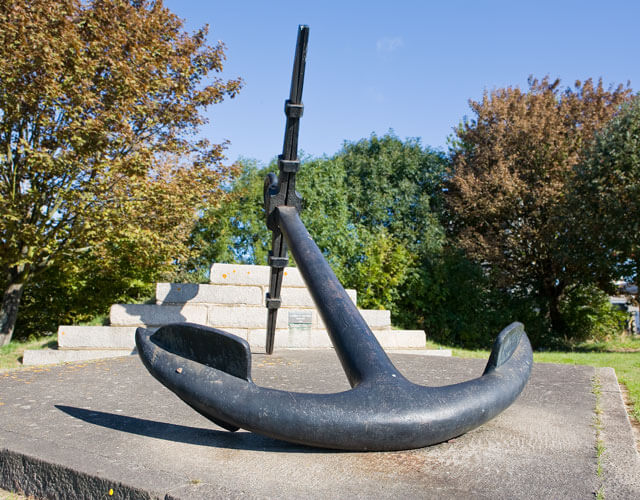
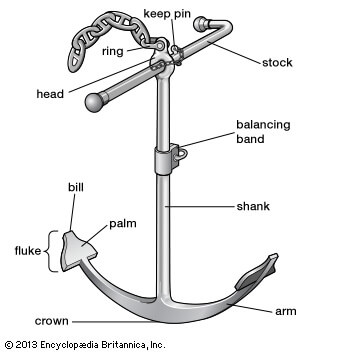
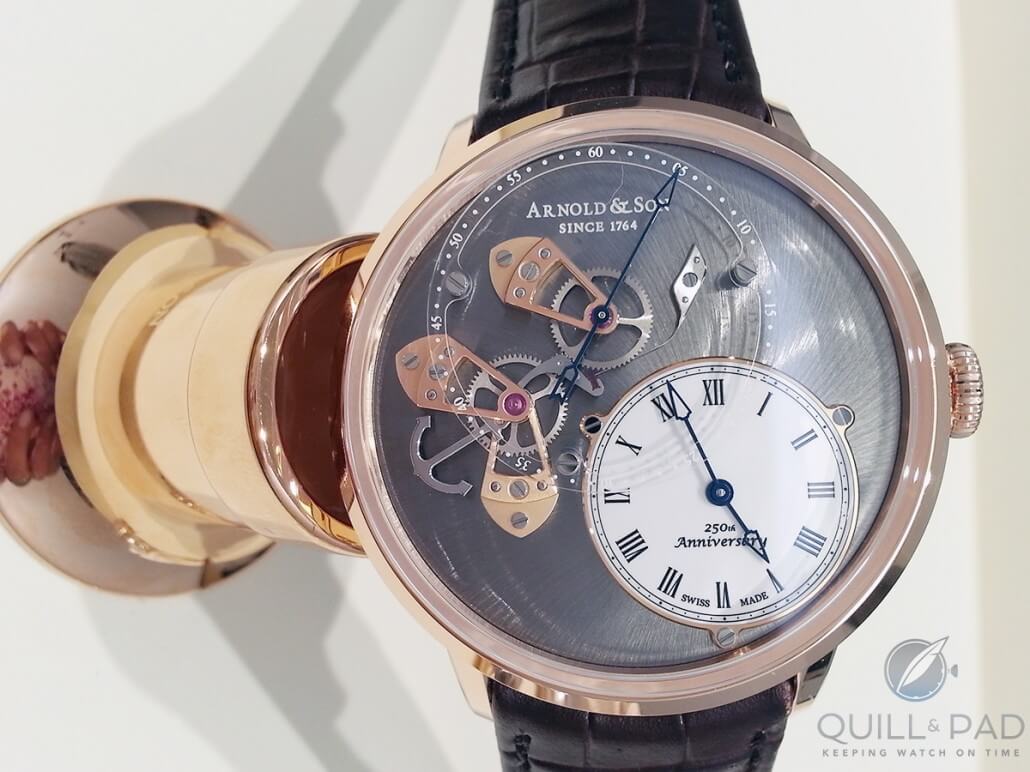
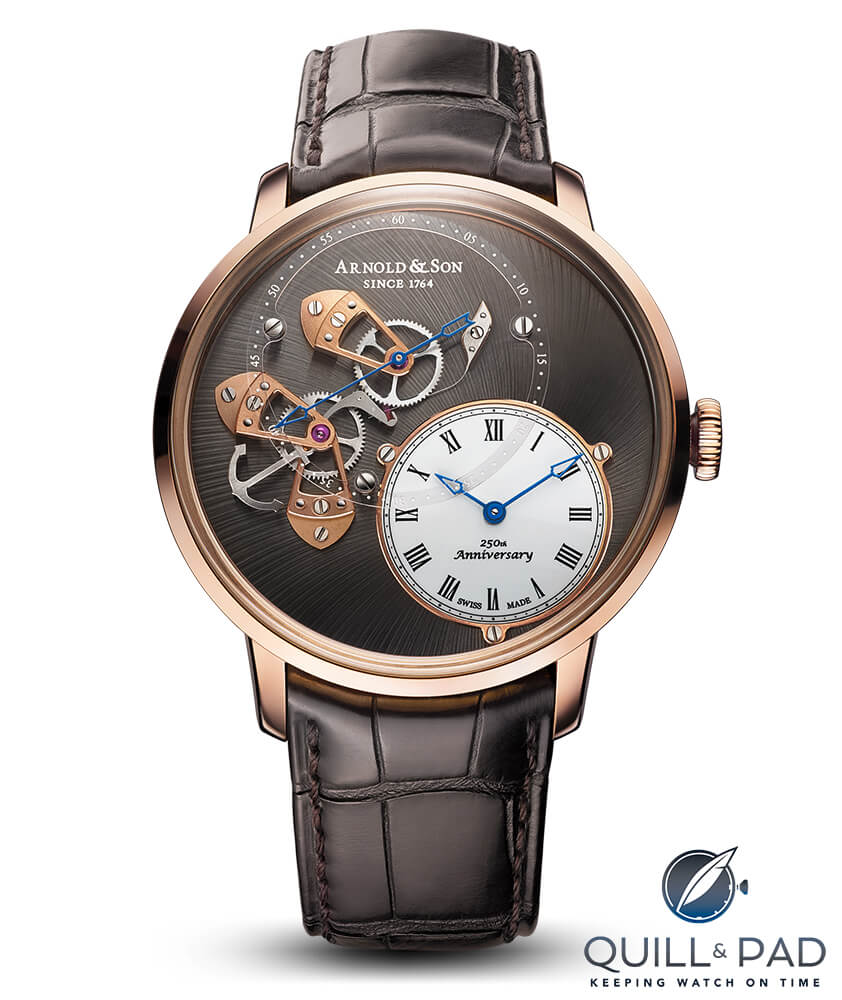
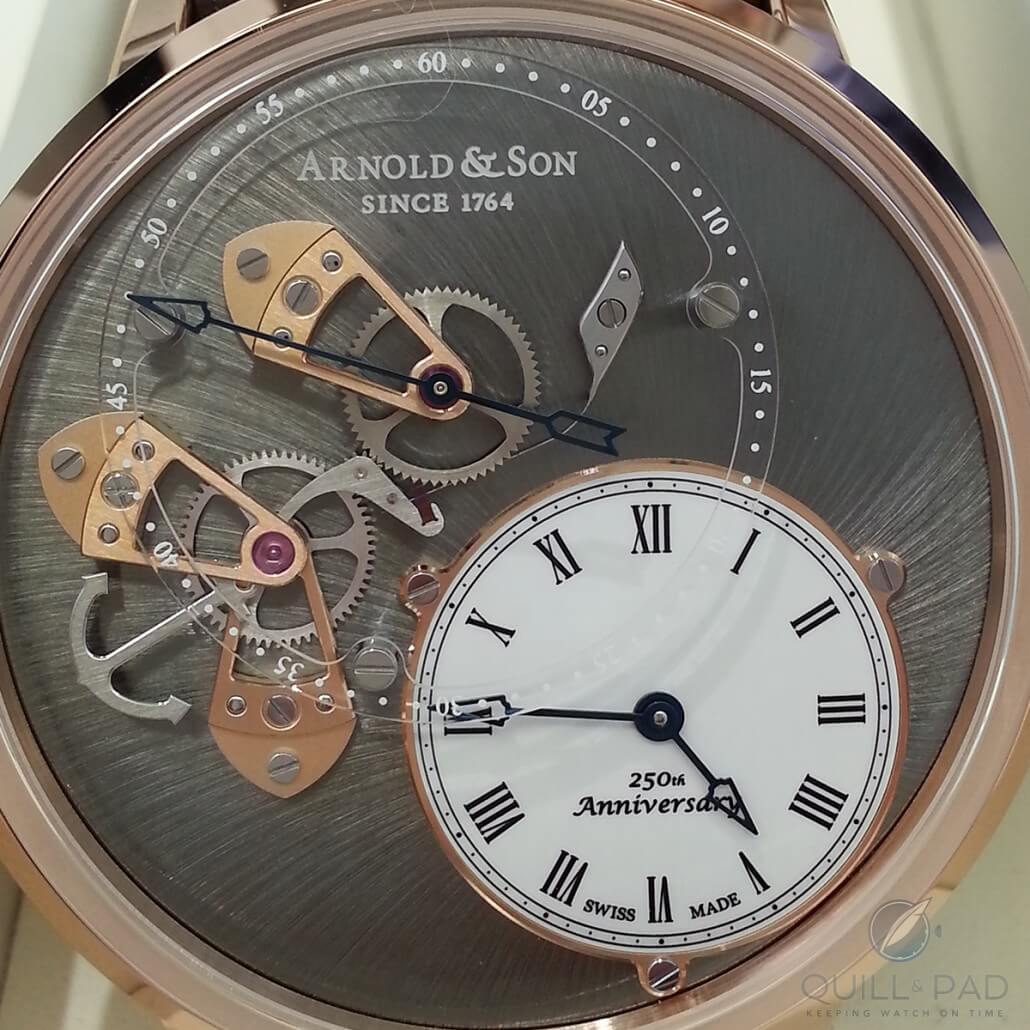
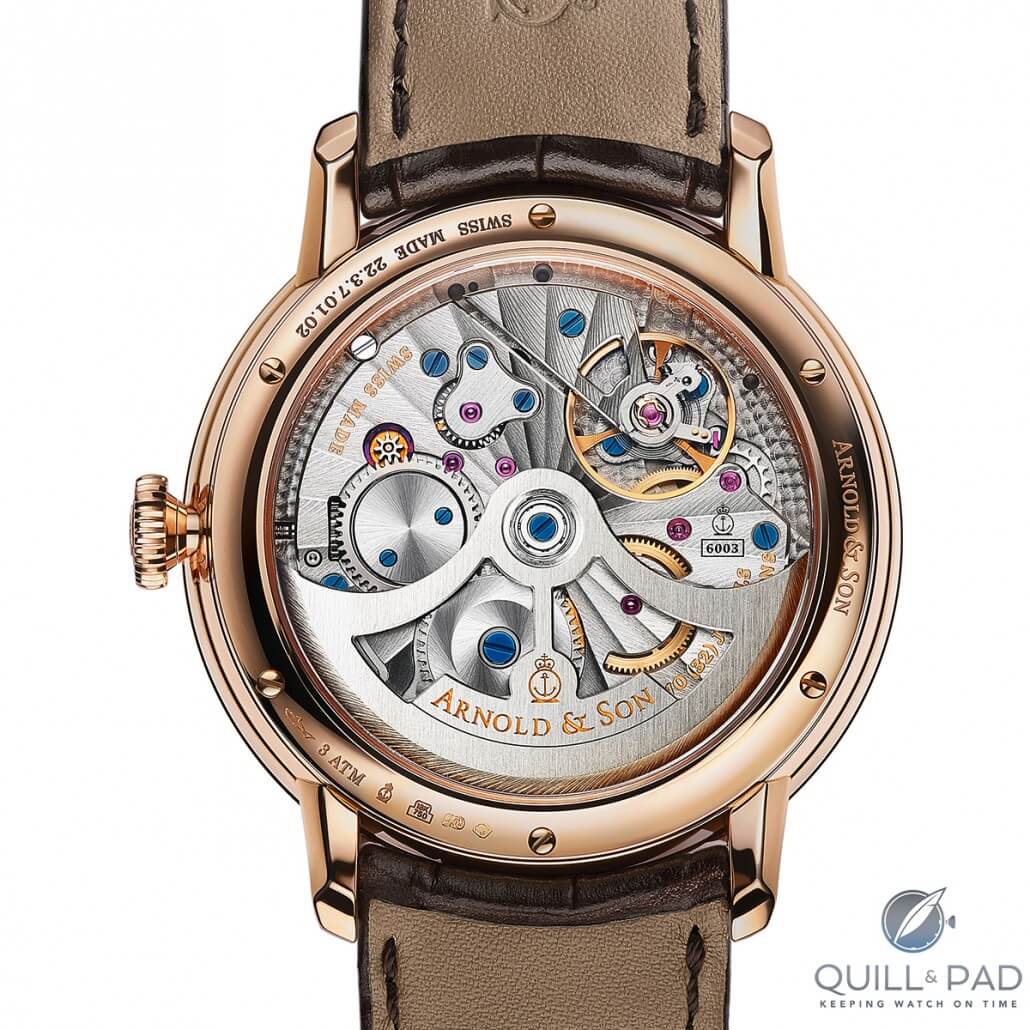
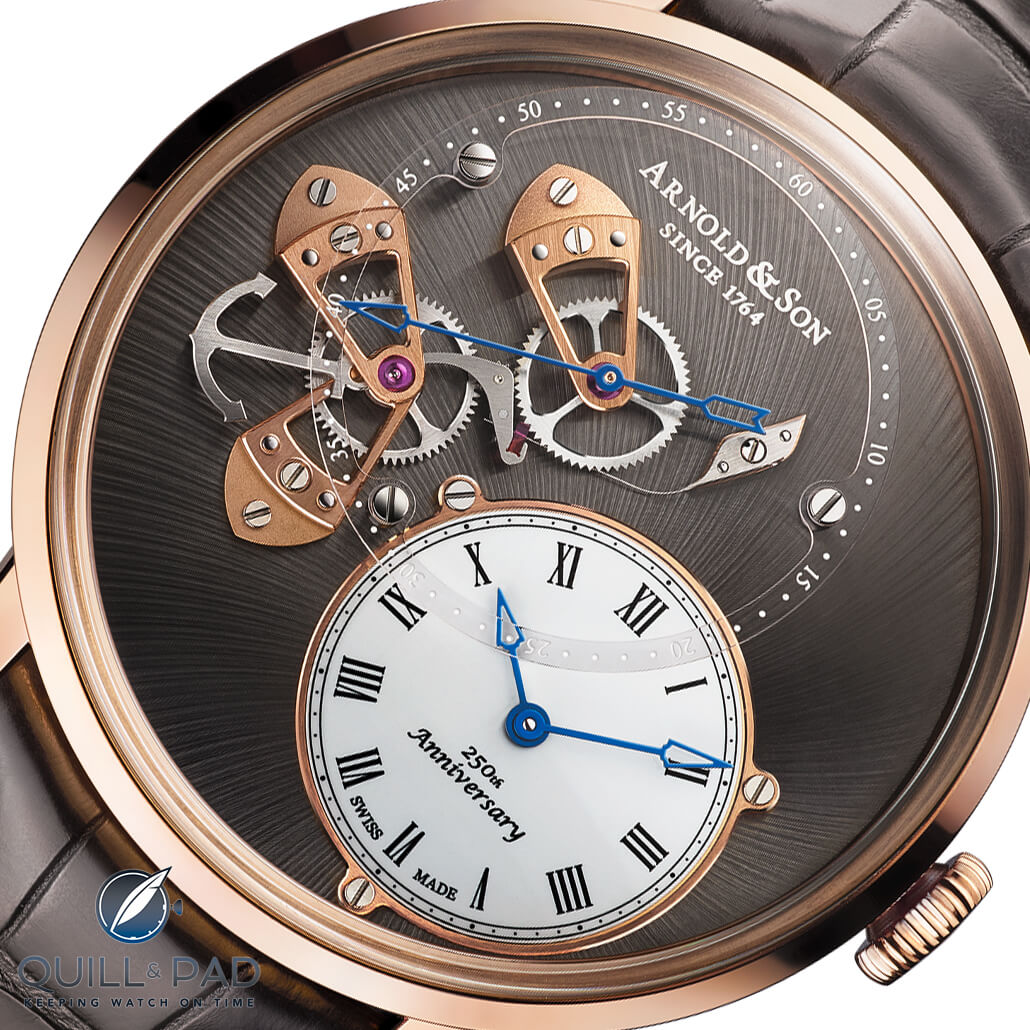
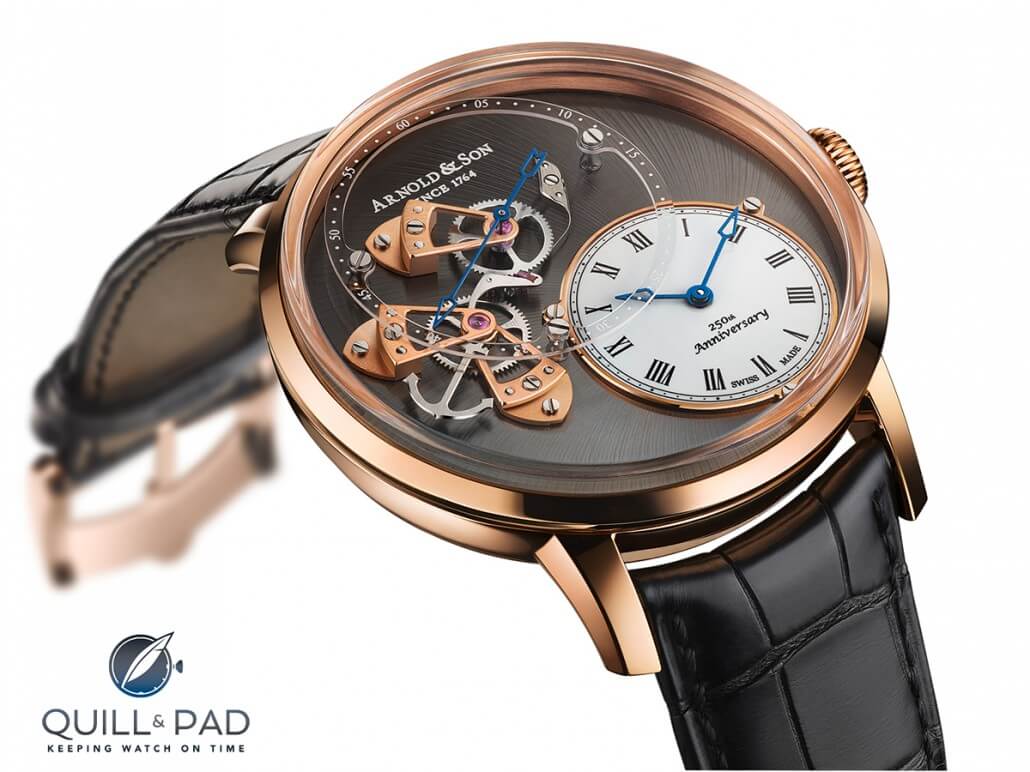
Trackbacks & Pingbacks
[…] You may also be interested in Anchors Ahoy! The Arnold & Son Dial Side True Beat (DSTB). […]
[…] You may also be interested in Anchors Ahoy! The Arnold & Son Dial Side True Beat (DSTB). […]
[…] el timón. Como característica notable en buques de este tamaño estaba el uso –todavía- del ancla tipo Almirantazgo, con cepo. El peso de cada una de ellas era de una tonelada. El aparato motos lo constituían dos […]
[…] For more on this model in red gold, please read Anchors Ahoy! The Arnold & Son Dial Side True Beat (DSTB). […]
[…] For more on this model in red gold, please read Anchors Ahoy! The Arnold & Son Dial Side True Beat (DSTB). […]
Leave a Reply
Want to join the discussion?Feel free to contribute!